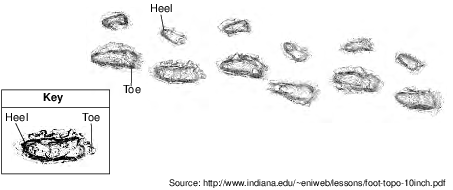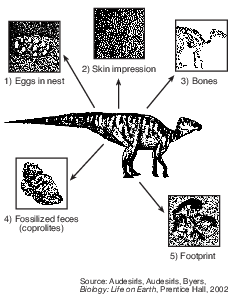Topic: Natural Selection And Evolution
Natural Selection And Evolution
Fossil Footprints
Scientists examined a trail of fossil footprints left by early humans in soft, volcanic ash in Eastern Africa. A drawing of the trail of footprints is shown below. Each footprint is represented as a series of lines indicating the depth that different parts of the foot sank into the volcanic ash.

The type of information directly provided by these fossil footprints is useful because it
(1) offers details about how these individuals changed during their lifetime
(2) offers data regarding their exposure to ultraviolet (UV) radiation
(3) is a record of information about what these individuals ate during their lifetime
(4) is a record of some similarities and differences they share with present-day species
In 2007, scientists broke open a fossil of a dinosaur bone and found some preserved tissues. Analysis showed that some proteins in these tissues are very similar to proteins found in modern chickens. The conclusion that these dinosaurs are related to modern chickens is based on
(1) molecular similarities
(2) natural selection
(3) similarities in behavior
(4) the occurrence of mutations
Evidence that best supports the theory of biological evolution was obtained from the
(1) investigation of environmental niches
(2) study of fossil records
(3) comparison of the number of cells in organisms
(4) analysis of food chains and food webs
Natural selection and its evolutionary consequences provide a scientific explanation for
(1) the fossil record of ancient life-forms
(2) predictions about the rate of global warming
(3) the amount of precipitation in a rain forest
(4) the amount of soil used to grow certain crops
Scientists who have examined the fossil record have noted that some species have changed very little over long periods of geologic time. The lack of change in such organisms is most likely because
(1) all members of their population were genetically identical, and they lived in a rapidly changing environment
(2) there was a large amount of variation in their population, and the environment changed frequently
(3) they could move between different environ- ments when food supplies became scarce
(4) the environment that they lived in remained the same, and they were well-adapted to it
The fossil record of ancient life forms provides scientific evidence of
(1) direct harvesting
(2) selective breeding
(3) gene manipulation
(4) evolutionary changes

Three species with the most similar traits are most likely
(1) F, I, G
(2) D, H, J
(3) B, D, G
(4) F, A, J
Which diagram below indicates that species D is more closely related to C than it is to either A or B?
(1) 
(2) 
(3) 
(4) 
The diagram below represents one possible evolutionary change that could have led lobe-finned fish to develop into the first amphibians. Amphibians are animals that live on land some of their life.

This change from fins on the lobe-finned fish to legs and feet on the early amphibian is most likely due to
(1) a sudden mutation that changed the gills of the lobe-finned fish to lungs
(2) increased competition between animals that had adapted to living on the land
(3) the need to move to land because of increased competition for food in the ocean
(4) variations among offspring, followed by natural selection
The diagram below represents a variety of fossil types, which can be found in many rocks.

These fossils can be best used to provide information that could be used in a study of
(1) evolutionary relationships
(2) dynamic equilibrium
(3) selective breeding
(4) cell specialization
A Close Relative of the Elephant
A hyrax is an animal that has been called a rock rabbit and looks like a guinea pig. Fossil records show that hyraxes first appeared on Earth approximately 37 million years ago. As they evolved, some became mouse-sized, while some were the size of a horse. Some eventually adapted to marine life and are related to manatees, and some became grazers and are related to elephants.

Identify one type of molecular evidence that could have been used to develop this mammalian evolutionary tree, and describe one specific way that the evidence could have been used to construct the tree. [1]
Evidence: ________________________________________
Allow 1 credit. Acceptable responses include, but are not limited to:
• Evidence: DNA
• — The more similar the DNA codes of organisms are, the closer the organisms will be on the
• tree.
• Evidence: Similar proteins
• — If organisms produce several similar proteins, they are likely to be closely related and closer
• on the evolutionary tree.
• Evidence: Amino acid sequences
• — The more amino acid sequences that are the same in two organisms, the more closely related
• they are.
Most animal fossils include hard body parts such as teeth and bones. Until recently, scientists had little hope that soft tissue could be preserved in the bones. A team of scientists has removed soft tissue containing a collagen protein from the leg bone of a 68-million-year-old fossil from a dinosaur, Tyrannosaurus rex. The technique of mass spectrometry was used to identify the sequences of certain molecules in several small fragments of the dinosaur collagen protein.
The molecular sequences were compared to those of modern animals. The scientist found that the collagen protein of the Tyrannosaurus rex more closely resembled the collagen protein found in modern chickens than that in some other modern animals.
State one kind of evidence that would support the conclusion that birds evolved from dinosaurs like Tyrannosaurus rex. [1]
Allow 1 credit. Acceptable responses include, but are not limited to:
• — The collagen protein of Tyrannosaurus rex more closely resembles the collagen protein of
• chickens than other animals.
• — similar bone structures
• — Similar proteins were identified in both.
New varieties of organisms have resulted from human activities. These organisms have often led to problems in modern society. Two of these new varieties are listed below.
Antibiotic-resistant bacteria Pesticide-resistant insects
Select one of these varieties and discuss a problem associated with the development of this new variety of organism. In your answer, be sure to:
• identify the variety you selected
• identify one biological process by which a population of this variety may develop resistance [1]
• describe how this process is involved in the production of a population of resistant organisms [1]
• identify one problem caused by this resistance [1]
• state one solution to this problem [1]
• identify one possible negative effect of this solution [1]
Variety: ________________________________
The student’s response to the bulleted items in the question need not appear in the following order.
• 13 Allow 1 credit for identifying one biological process by which a population of this variety may develop resistance. Acceptable responses include, but are not limited to:
• — natural selection
• — evolution
• — reproduction
• — mutation
• 14 Allow 1 credit for describing how this process is involved in the production of a population of resistant organisms. Acceptable responses include, but are not limited to:
• Natural Selection:
• — The population had some members that were naturally resistant to antibiotics. They survived and reproduced, passing on the resistance.
• Evolution:
• — Some organisms were resistant to the pesticide. They survived and passed on the trait.
• Reproduction:
• — Resistant members survived and passed on the trait.
• Mutation:
• — It produces variations that give some organisms a survival advantage.
• Note: Allow credit for a response consistent with the process identified in question 13 .
• 16 Allow 1 credit for identifying one problem caused by this resistance. Acceptable responses include, but are not limited to:
• — Resistant bacteria will survive and continue to make people sick.
• — Insects will continue to destroy crops.
• — Antibiotics do not work anymore.
• — There will be less food available.
• 17 Allow 1 credit for stating one solution to this problem. Acceptable responses include, but are not
• limited to:
• — Do not use antibiotics/antibacterial products unless needed.
• — Use different antibiotics or pesticides.
• — Use a natural predator for pests.
• — Insert genes into plants that will make them resistant to bacteria or pests.
• — Research and find new antibiotics/ways of controlling insect pests.
• Note: Allow credit for a response consistent with the problem identified in question 16 .
• 19 Allow 1 credit for identifying one possible negative effect of this solution. Acceptable responses include, but are not limited to:
• — People might be sick longer.
• — More people could get sick.
• — Organisms may become resistant to other treatments.
• — Natural predators may get out of control.
• — Inserted genes may have an undesired effect.
• — Research takes a lot of time and money.
• Note: Allow credit for a response consistent with the student’s solution to question 17 .
The diagram below shows a branching “tree” representing the evolution of ten different groups of organisms alive today.

Identify the group of organisms that is most closely related to the Arthropoda group. Support your answer. [1]
Group of organisms:_______________________
Allow 1 credit for Annelida and supporting the answer.
• — They are closer to each other on the branch (tree).
• — Arthropoda and Annelida share a specific common ancestor that the other organisms don’t
• share.
Ocean-dwelling (marine) iguanas and land iguanas inhabit the Galapagos Islands. Some scientists believe that both types of iguanas diverged from a common ancestor. Marine iguanas eat algae. Land iguanas feed on cacti. Algae are more abundant in the ocean than cacti are on the islands. Both species lay their eggs in the sand.
Rats, cats, and goats have been introduced to the islands by humans. Rats feed on iguana eggs, cats eat baby iguanas, and goats eat cacti.
Identify the process by which ancestral iguanas developed into the present-day marine iguanas and land iguanas of the Galapagos Islands. [1]
Process: ________________________
Allow 1 credit. Acceptable responses include, but are not limited to:
• — evolution/natural selection
• — adaptive radiation
• — speciation
